Visiting a shrine is an integral part of any journey to the land of the rising sun. Most of us have heard through guidebooks of the likes of Kyoto’s Fushimi Inari Shrine, Hiroshima’s Itsukushima Shrine and Meiji Shrine in Tokyo, etc. However, there are many more spots – hidden secret shrines worth checking out.
One such example is Kameido Tenjin Shrine, located in the Koto Ward of Tokyo. It has over 350 years of history. It’s not small, but it is also not large enough to be in tourist booklets, and is therefore still not too well known even within Japan.
The name Kameido comes from the name of the quant vicinity of land located close to the very eastern part of Tokyo. It’s a locale that is forever a step or two behind the trending areas. In actuality, up until a mere 10 years ago, former refined ladies of the night could be seen strutting their stuff down the streets. Owing to many left over influences of this former era, the area has a certain charm about it, and the general atmosphere of this traditional area of Tokyo is savoured. What’s more, in Spring the Kameido Tenjin Shrine holds the Fuji Matsuri (wisteria festival). While not a famous event, the hanging wisteria is a cherished sign of the season for local residents. Soon we will hit the peak of the wisteria season. How about stretching your legs, and going to admire the beautiful light purple flowers?
Turning on Kuramaebashi Dori will reveal this landmark; a large torii gate

It takes approximately 15 minutes on foot from JR Sobu train station to reach Kameido Tenjin Shrine. Go straight on Meiji Dori in front of the station, turn left at the Kameido 4-chome intersection, enter Kuramaebashi Dori, and after a short while the shrine is on your right. Following the guide to the entrance found before the main gate is not recommended if it is your first visit, as it is a shortcut for entering via the eastern gate. If you enter the shrine grounds from the main gate – through the large torii – you can walk down the main road approaching the shrine.
The splendid main hall which is dedicated to the god of learning
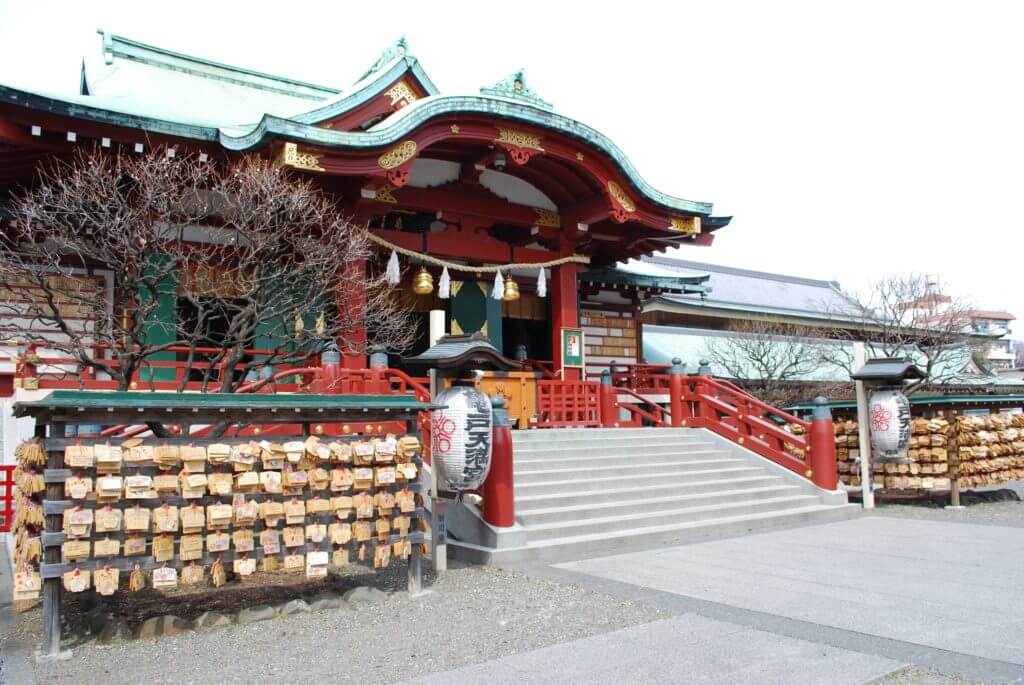
Inside the shrine grounds, we come across a large pond and 3 bridges. The first bridge to cross is Taikobashi – a male arched bridge. Next is a broad bridge, then a female arched bridge. The bridges represent the past, the present, and the future; crossing these bridges cleanses the soul. Care must be taken crossing the male and female bridges, as they are quite angular.
The main hall rises from the inner section of the grounds, and enshrines Sugawara no Michizane. Sugawara no Michizane was a poet and politician of the Heian period. Because of the many natural disasters after his death, he was worshiped as a deity. He was particularly active in academic matters; so many people come to pray before their school entrance exams. The famous Dazaifu Tenmangu Shrine in Kyushu also has its history linked to Sugawara no Michizane. The Dazaifu Shrine in the west regards the Kameido Tenjin Shrine as the “Dazaifu Tenmangu Shrine of the East”.
There are plenty of items to check out in the vicinity of the main hall: a monument inscribed with “bullfinch”, a godly bull, as well as many lanterns, etc.
Wisteria trellises spread across the inner grounds of the shrine.
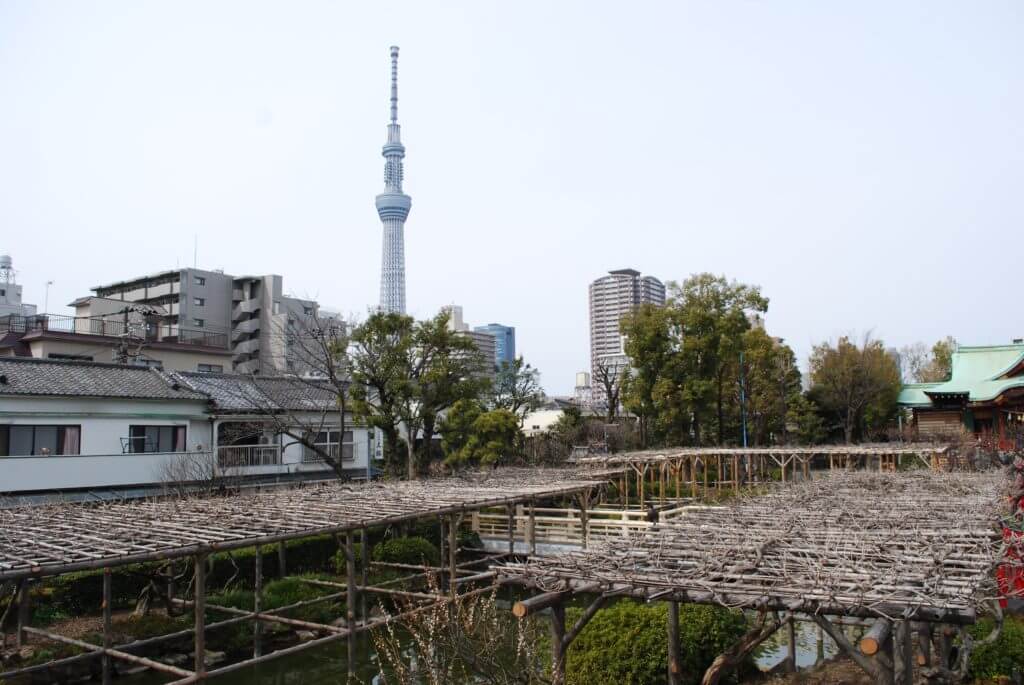
Japanese wisteria is cultivated close together on trellises with the Tokyo Skytree in close proximity making its presence felt. In the off-season (autumn and winter) the wisteria is nothing special, but come spring they all bloom together, and this shrine is famous as being Tokyo’s best location for viewing the flowers.
The Fuji Matsuri takes place every year from late April to early May.
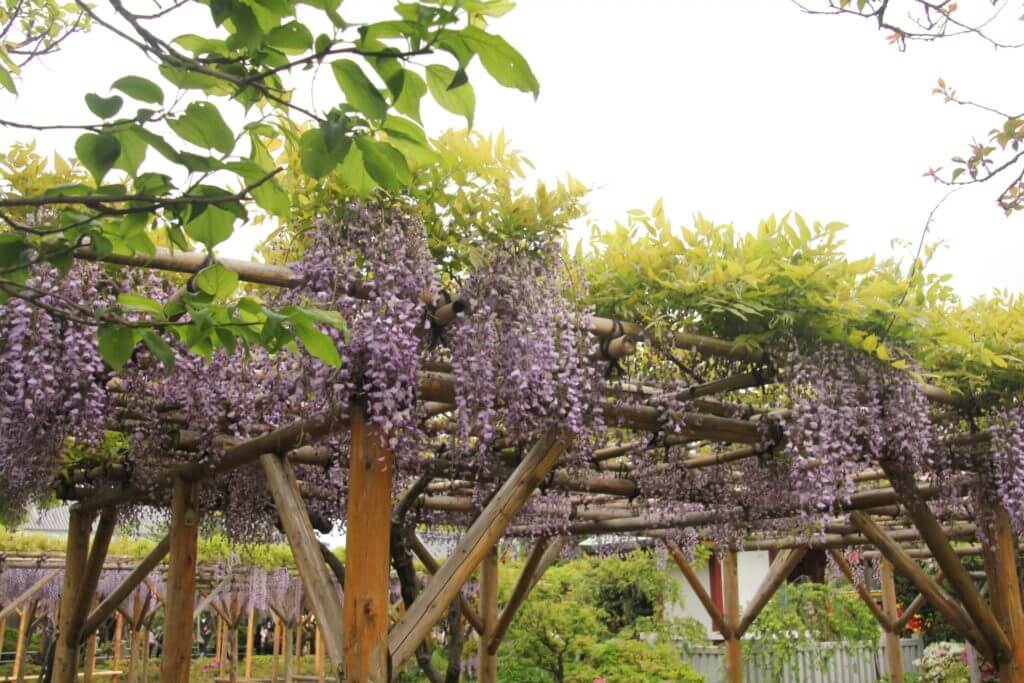
Come the second half of April, the wisteria flowers all bloom at once; this marks the beginning of the Fuji Matsuri. To see over 50 plants blooming in unison is a rare sight, unmatched anywhere in Japan. The reflection of this scene in the pond, as well as the subtle aroma, attracts many people. In modern times it is also rare to see the number of the shops utilizing food carts as we do in this area – this adds to the friendly atmosphere of the traditional neighbourhood.
After dark you can enjoy a lighting display, compared to the daytime the atmosphere becomes more fairy tale like.
Nearby is the original creator of kuzu mochi; Funabashiya.

Kuzu mochi, created by fermenting the starch of wheat, was first crafted at this shop, Funabashiya, near Kameido Tenjin Shrine in 1805. The shop was most famous at the start of the Meiji period – being listed as the grand champion in the Edo Sweet Stores Ranking List. To this day the shop has a continuous flow of customers visiting. Apart from kuzu mochi, they also offer products such as anmitsu (a sweet with red bean paste) and tokoroten (seaweed jelly strips). The offerings are available as both souvenirs or to have as eat in. It’s a place to visit on your way home from the shrine.
Check out the 100 year old shop selling beans on your way home.
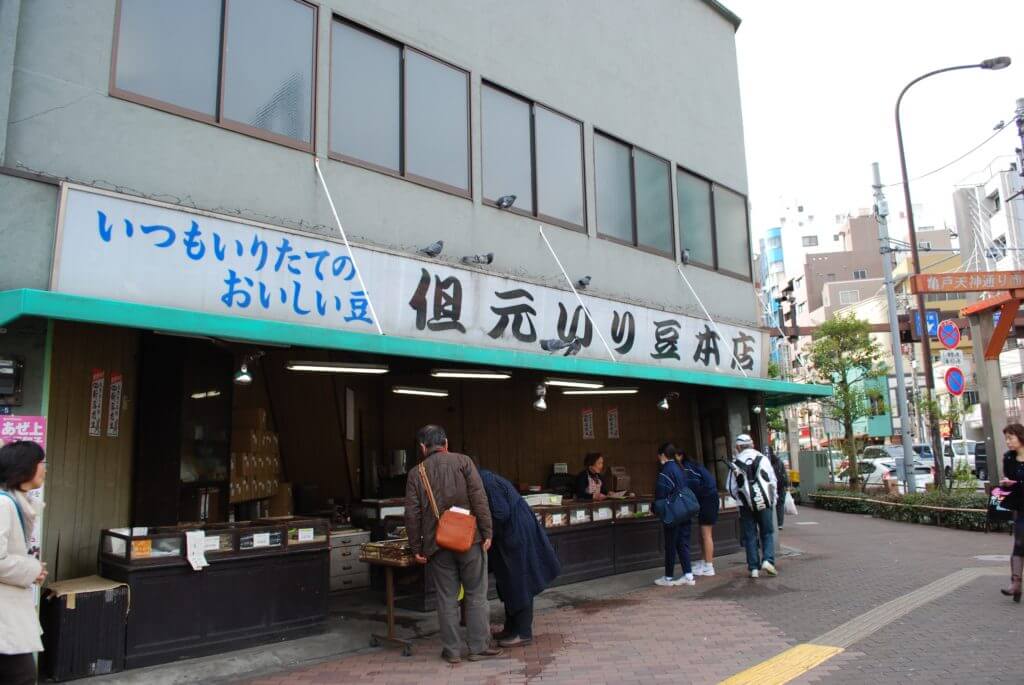
On the way to the Kameido station, at the entrance to the Jusankan Dori shopping arcade, is a roasted bean shop established in 1916 called Tajimoto Irimame. They have continued to provide shiomame, hanamame, katamame – all sorts of bean based confectionary – and have regular customers that continue to visit from faraway areas going back three generations. Their most popular product, the shiomame (salted beans), goes perfectly together with beer or Japanese sake.
Don’t miss the home style food outlets around the station area!
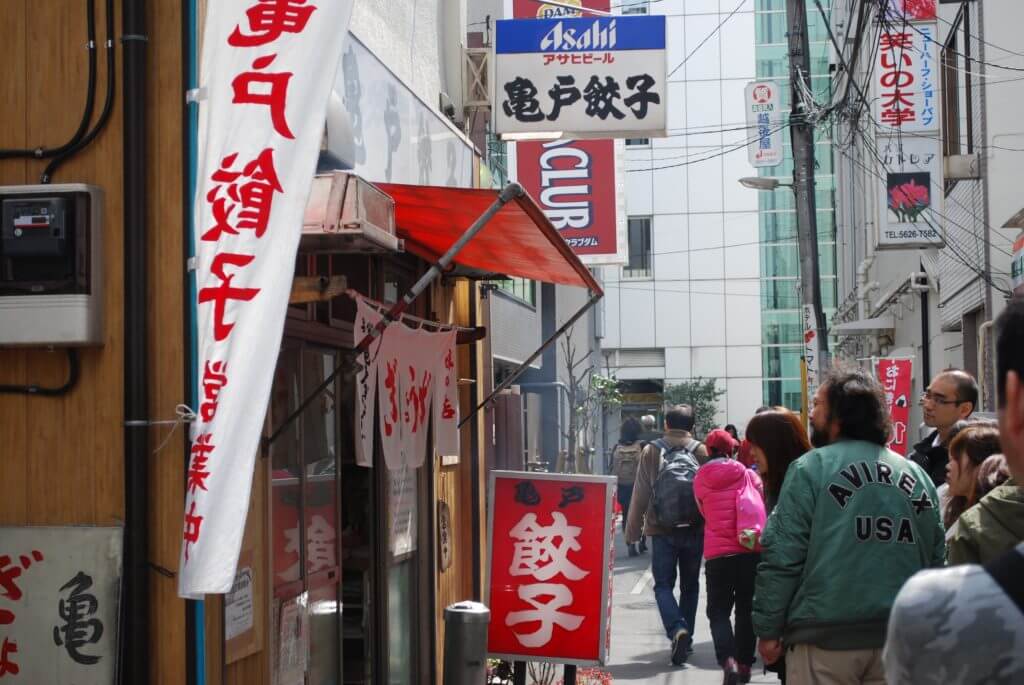
On the back streets around Kameido station, there are many eateries (such as Kameido gyoza (dumpling) and Kameido grilled innards) worthy of people lining up to enter. Everywhere is reasonably priced and good quality, so if time permits it’s well worth your time. Especially Kameido gyoza – the all gyoza course – cannot be experienced elsewhere. Eating like a true Tokyoite is sure to be a great memory.
The area around Kameido Tenjin Shrine resembles the atmosphere of sightseeing spots such as Asakusa, but there is a sense of experiencing the true local Tokyo, which is not as refined. If you go off the beaten track just a bit, into the quieter, more local areas, you are sure to feel the charms of the good old days of Japan.
Edit & Text:K. Sachio
<PROFILE>
Editor and writer.
Works in fashion magazines and many other genres such as culture, gourmet, etc.A person who loves animals, family, and has a hardcore sweet tooth.
















Comment